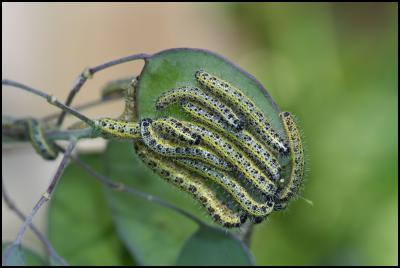Attempt Underway To Eradicate Major Butterfly Pest
13 December 2012
Attempt Underway To Eradicate Major
Butterfly Pest
A multi-agency attempt is being made to eradicate the great white butterfly in Nelson city in a bid to clear New Zealand of the introduced pest which poses a major economic and environmental threat.
The help of Nelson Tasman residents is being called on as it will be vital to achieving eradication. Householders are being asked to search their gardens for the pest butterfly’s caterpillars and report sightings to the Ministry of Primary Industries hotline 0800 80 99 66.
The caterpillars can be readily identified by feeding in groups on plants they favour, including brassica vegetables, particularly cabbages and broccoli, and nasturtiums and honesty. The caterpillars are speckled black and greyish-green with three yellow lines along their bodies.
The great white butterfly was discovered in a Nelson garden in 2010 and so far is only known to be in the city. It is a threat to New Zealand commercial and home brassica vegetable crops and to native cresses, including some at risk of extinction.
The Department of Conservation is leading the eradication attempt in conjunction with Vegetables New Zealand, the Ministry for Primary Industries, Tasman District Council, and Nelson City Council.
Eradication will be carried out on the ground and entail physical removal of caterpillars and eggs and, as necessary, applying an organic insecticide to host plants.
DOC Motueka Area Manager Martin Rodd said the department had decided to attempt to eradicate the great white butterfly, with the other agencies’ support, because it could have serious consequences for the survival of many native cress species.
‘New Zealand has around 79 native cress species, 57 of which are at risk of extinction, many of which could be decimated by the great white butterfly.
‘In attempting to eradicate the great white butterfly from Nelson, we are attempting to eradicate it from New Zealand and stop it becoming established as a major pest in this country. The species can fly long distances - sometimes hundreds of kilometres - so would eventually spread throughout New Zealand if left unchecked.
‘There have been more than 275 confirmed great white butterfly infestations within a 6-kilometre radius of Port Nelson since it was first found in 2010, most of them inside 3 kilometres. We have the best chance of eradicating the butterfly while it is still contained within a relatively small area.
‘We urge the Nelson public to support the eradication programme by looking for the butterfly’s caterpillars and eggs and reporting suspected finds of them. We are also asking people further out from Nelson, such as Richmond and Tasman, to look for the pest so we can find out whether it has spread beyond the city.
Tasman-based Vegetables New Zealand Director, Mark O’Connor said the vegetable industry supported the eradication programme because of the strong probability the pest butterfly would spread and become established in New Zealand if left unmanaged.
‘This insect is already a significant pest of brassica crops in numerous countries including Europe, Britain and India due to the damage caused by the larvae (caterpillars that reach 4 cm in length) voraciously defoliating leaves, reducing the host plant to a skeleton.
‘The pest’s preferred food includes vegetable brassicas, forage brassicas and oil-seed rape (canola). In New Zealand, all these crops are important, with about 4000 hectares of vegetable brassicas grown worth approximately $80 million per year, and a rapid expansion in production of forage brassicas, mainly for dairy production to about 300,000 hectares grown annually, with the majority grown in Canterbury.’
The great white butterfly eradication programme is being carried out by a team from Entecol Ltd led by Nelson insect ecologist Richard Toft under contract to DOC.
Reported finds of great white butterfly caterpillars are followed up with a visit by the field team. If it is confirmed to be the great white butterfly, gardens will be searched for others and those found removed. Plants on neighbouring properties also need to be checked as they could also have infestations. Householders support is sought for this search and eradication programme.
The adult great white butterfly looks similar to the small white butterfly, though about twice the size, and it is generally easier for people to distinguish between the two by their different caterpillars. A distinctive difference is that the great white’s caterpillars are mostly found in tight groups whereas the small butterfly caterpillar is more often found singly.
The great white butterfly caterpillar’s appearance changes through five growth stages. When first emerging from the egg, the tiny caterpillars are yellowish with a shiny black head. Then dark spots begin to appear on the body. In later stages, it is speckled greyish-green and black and has three yellow lines along each side and the top of the body. The larger caterpillars, which grow to 45 mm in length, have lots of pale hairs.
In contrast, the small white butterfly caterpillar is uniformly green with a faint yellow line along the top of its body.

Click for big version.
• Research is also being carried out to assist with eradication and management of the great white butterfly. The Ministry for Primary industries is conducting research on detection and surveillance tools (e.g. lure and kill trapping) to help with eradication of the butterfly pest. Vegetables NZ will be working with Plant & Food Research on research into biological controls of both the great white butterfly and the small white butterfly species. The research will entail investigation of the levels of parasitism of eggs, larvae and pupae by biological control agents already present in the Nelson area. This MPI Sustainable Farming Fund project will also see the transfer of a second larval biological control agent from Canterbury to brassica crops near Nelson next autumn. This program will provide information about biological control of the new great white butterfly pest as well as enhancing the level of biological control of the small white butterfly pest in crops and home gardens in the Nelson region.
• The great white butterfly lays its yellow eggs on host plants in batches of 30 – 100 eggs. In contrast, the small white butterfly lays its more cream-coloured eggs singly or in pairs.
• Adult great white butterflies look very similar to the common small white butterflies though somewhat larger. The upperside of the wings are white, with a black tip and females have two black dots and a black smear. The male butterfly doesn’t have the black spots on the upper side of the forewings. When the butterfly’s populations reach high densities they have a tendency to mass-migrate over long distances to new locations – sometimes hundreds of kilometres.
• One highly endangered native cress species found only in inner Tasman Bay is particularly at risk from the great white butterfly given the proximity of Nelson city. The coastal peppercress, Lepidium banksii, has a threat status of nationally critical and is struggling to survive. The few surviving wild populations, mostly now confined to DOC-managed islands, are already being badly impacted by small white butterflies and some other introduced insects.
Department of
Conservation—Te Papa Atawhai
Conservation for prosperity Tiakina
te taiao, kia puawai
www.doc.govt.nz
ENDS


 Gordon Campbell: On Israel’s Murderous Relapse, And Peters’ Sad Decline
Gordon Campbell: On Israel’s Murderous Relapse, And Peters’ Sad Decline LGNZ: Strong Community Voice Vital For RMA Reforms
LGNZ: Strong Community Voice Vital For RMA Reforms NZ Police: Gang Conflict Warrant Issued Following Tairāwhiti Gang Tensions
NZ Police: Gang Conflict Warrant Issued Following Tairāwhiti Gang Tensions Green Party: Greens Question Govt Commitment To Environmental Protection With RMA Reform
Green Party: Greens Question Govt Commitment To Environmental Protection With RMA Reform Water Safety NZ: Children Need Us To Protect Them Around Water
Water Safety NZ: Children Need Us To Protect Them Around Water  NZ Government: Cost Of Living Support Coming For 1.5 Million New Zealanders
NZ Government: Cost Of Living Support Coming For 1.5 Million New Zealanders NZ First Party: Winston Peters' State Of The Nation - 'Make New Zealand First Again'
NZ First Party: Winston Peters' State Of The Nation - 'Make New Zealand First Again'


